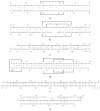Algal lectins as potential HIV microbicide candidates
- PMID: 22851920
- PMCID: PMC3407925
- DOI: 10.3390/md10071476
Algal lectins as potential HIV microbicide candidates
Abstract
The development and use of topical microbicides potentially offers an additional strategy to reduce the spread of the Human Immunodeficiency Virus (HIV). Carbohydrate-binding agents (CBAs) that show specificity for high mannose carbohydrates on the surface of the heavily glycosylated envelope of HIV are endowed with potent anti-HIV activity. In fact, a number of algal lectins such as cyanovirin-N, microvirin, microcystis viridis lectin, scytovirin, Oscillatoria agardhii agglutinin and griffithsin are considered as potential microbicide candidates to prevent the sexual transmission of HIV through topical applications. They not only inhibit infection of cells by cell-free virus but they can also efficiently prevent virus transmission from virus-infected cells to uninfected CD4(+) target T-lymphocytes and DC-SIGN-directed capture of HIV-1 and transmission to CD4(+) T lymphocytes. This review focuses on the structural properties and carbohydrate specificity of these algal lectins, their antiviral activity against HIV and several other enveloped viruses, their safety profile and viral resistance patterns.
Keywords: HIV; algae; carbohydrate-binding agents; gp120 envelope; lectin; microbicide; virus entry.
Figures




Similar articles
-
Microvirin, a novel alpha(1,2)-mannose-specific lectin isolated from Microcystis aeruginosa, has anti-HIV-1 activity comparable with that of cyanovirin-N but a much higher safety profile.J Biol Chem. 2010 Aug 6;285(32):24845-54. doi: 10.1074/jbc.M110.128546. Epub 2010 May 27. J Biol Chem. 2010. PMID: 20507987 Free PMC article.
-
The lectins griffithsin, cyanovirin-N and scytovirin inhibit HIV-1 binding to the DC-SIGN receptor and transfer to CD4(+) cells.Virology. 2012 Feb 20;423(2):175-86. doi: 10.1016/j.virol.2011.12.001. Epub 2011 Dec 29. Virology. 2012. PMID: 22209231 Free PMC article.
-
Broad anti-HIV activity of the Oscillatoria agardhii agglutinin homologue lectin family.J Antimicrob Chemother. 2014 Oct;69(10):2746-58. doi: 10.1093/jac/dku220. Epub 2014 Jun 25. J Antimicrob Chemother. 2014. PMID: 24970741 Free PMC article.
-
Antiviral Cyanometabolites-A Review.Biomolecules. 2021 Mar 22;11(3):474. doi: 10.3390/biom11030474. Biomolecules. 2021. PMID: 33810129 Free PMC article. Review.
-
Algal lectins for potential prevention of HIV transmission.Curr Med Chem. 2008;15(11):1096-104. doi: 10.2174/092986708784221421. Curr Med Chem. 2008. PMID: 18473805 Review.
Cited by
-
(1)H, (13)C and (15)N resonance assignment of the anti-HIV lectin from Oscillatoria agardhii.Biomol NMR Assign. 2015 Oct;9(2):317-9. doi: 10.1007/s12104-015-9600-8. Epub 2015 Feb 14. Biomol NMR Assign. 2015. PMID: 25680849 Free PMC article.
-
Pharmacokinetics of the Antiviral Lectin Griffithsin Administered by Different Routes Indicates Multiple Potential Uses.Viruses. 2016 Dec 17;8(12):331. doi: 10.3390/v8120331. Viruses. 2016. PMID: 27999325 Free PMC article.
-
Isolation of Industrial Important Bioactive Compounds from Microalgae.Molecules. 2021 Feb 10;26(4):943. doi: 10.3390/molecules26040943. Molecules. 2021. PMID: 33579001 Free PMC article. Review.
-
Biosynthesis and function of extracellular glycans in cyanobacteria.Life (Basel). 2015 Jan 12;5(1):164-80. doi: 10.3390/life5010164. Life (Basel). 2015. PMID: 25587674 Free PMC article. Review.
-
The root extract of the medicinal plant Pelargonium sidoides is a potent HIV-1 attachment inhibitor.PLoS One. 2014 Jan 29;9(1):e87487. doi: 10.1371/journal.pone.0087487. eCollection 2014. PLoS One. 2014. PMID: 24489923 Free PMC article.
References
-
- Abdool K.Q., Abdool Karim S.S., Frohlich J.A., Grobler A.C., Baxter C., Mansoor L.E., Kharsany A.B., Sibeko S., Mlisana K.P., Omar Z., et al. Effectiveness and safety of tenofovir gel, an antiretroviral microbicide, for the prevention of HIV infection in women. Science. 2010;329:1168–1174. - PMC - PubMed
-
- Leonard C.K., Spellman M.W., Riddle L., Harris R.J., Thomas J.N., Gregory T.J. Assignment of intrachain disulfide bonds and characterization of potential glycosylation sites of the type 1 recombinant human immunodeficiency virus envelope glycoprotein (gp120) expressed in Chinese hamster ovary cells. J. Biol. Chem. 1990;265:10373–10382. - PubMed
Publication types
MeSH terms
Substances
LinkOut - more resources
Full Text Sources
Other Literature Sources
Medical
Research Materials

